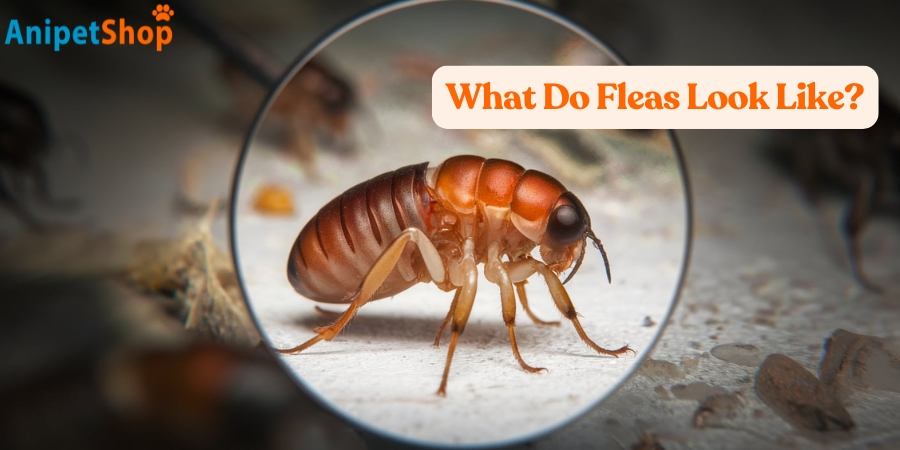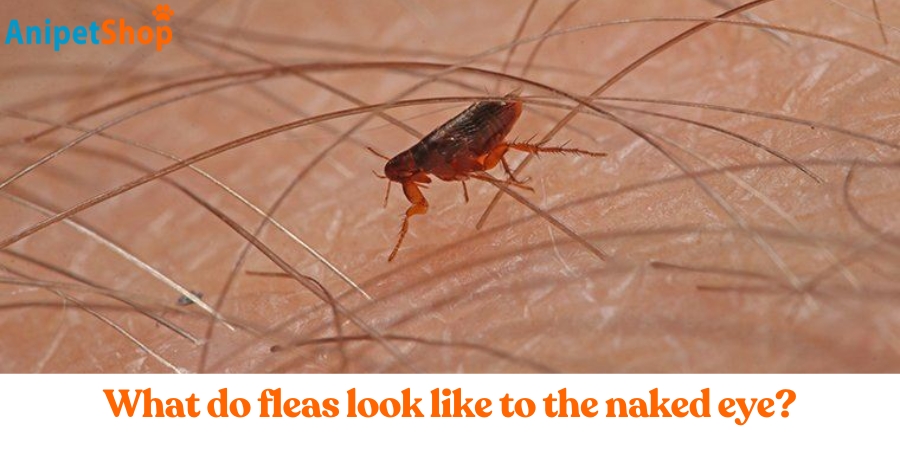What Do Fleas Look Like?
Fleas are more than just annoying pests; they can become a serious problem for both you and your pets. These tiny critters not only cause itchy, red bites but also have the potential to spread diseases and parasites, such as tapeworms.
Whether you’re facing a full-scale infestation or simply want to stay ahead of potential issues, recognizing what fleas look like is essential. Knowing how to identify these unwanted visitors will help you take swift and effective action to keep your home and pets flea-free.

What do fleas look like to the naked eye?
To the naked eye, fleas appear as tiny, dark, oval-shaped insects with tough shells, usually around 2.5 mm in length, making them difficult to spot unless you know what to look for. Fleas are agile and quick, often darting through the fur or clinging tightly to your pet’s skin to feed. As you comb through your pet’s fur, you may spot them darting through the hair or clinging to your pet’s skin to feed on their blood.
Fleas are tiny, dark, oval-shaped insects with hard shells, usually around 2.5 mm in length, making them difficult to spot unless you know what to look for. These pests are often yellow, red, or dark brown, which can make them easier to see on pets with light or white fur.
If your pet has lighter fur, wetting their coat and using a fine-toothed comb can help expose fleas, especially around the belly, neck, and base of the tail, where fleas often hide. Wetting the fur makes it easier to part and inspect, allowing you to look closely for small, fast-moving, dark specks. Fleas, as blood-feeding parasites, embed themselves to consume blood, with a female flea capable of ingesting up to 15 times her body weight in blood each day. This blood loss can lead to itching and discomfort for your pet and may even cause anemia in smaller pets if infestations are severe.
For a comprehensive inspection, focus on areas fleas are likely to gather, such as the belly, neck, and tail base. While combing, you may also find flea dirt—tiny black specks of digested blood that look like pepper flakes—indicating active flea presence. Observing these signs early and closely helps in detecting fleas and addressing infestations before they worsen.

What do fleas look like under a microscope?
Examining a flea under a microscope reveals fascinating details about its anatomy. Fleas have an oval-shaped body and a small head, with six legs extending from their body, designed specifically for mobility and survival. The back legs are noticeably longer than the front ones and function like springs, allowing the flea to jump impressive distances—up to 200 times their body length—to quickly latch onto a host. These specialized legs are crucial, as they enable fleas to leap directly from the environment onto an animal, avoiding the need to crawl long distances.
Under high magnification, you’ll also see a hard exoskeleton, giving the flea its resilience against pressure. This tough, shell-like outer layer is both protective and flexible, allowing fleas to withstand the challenges of their host’s environment. Their body is covered with tiny hairs and spines that point backward, helping them cling tightly to their host’s fur or feathers and making them harder to remove.
Fleas also have specialized mouthparts visible under a microscope, including piercing-sucking parts designed for penetrating the skin of animals and drawing blood. Unlike other insects, fleas do not have wings; instead, they rely solely on their powerful legs to travel, making them one of nature’s most efficient jumpers. Up close, their segmented bodies and dangling legs give them a somewhat alien appearance, with a resemblance to crustaceans, like shrimp, due to their hard shells and jointed limbs.

What does a flea infestation look like?
A flea infestation often becomes apparent through secondary signs rather than the fleas themselves, as these insects are small and quick. One of the earliest indicators of an infestation is the appearance of bite marks on both pets and people. For humans, flea bites typically show up on the lower body—around the feet, ankles, and legs—as fleas tend to jump from the floor to bite exposed skin. However, fleas can bite anywhere on the body, especially if they are in areas where people or pets rest.
Flea bites are usually identifiable by the redness or darker rash that forms around the bite. For many people, the bites may appear as small, red, itchy bumps with a tiny scab in the center. The severity of the reaction often depends on skin sensitivity, and some individuals may develop more pronounced rashes or welts around the bite area. Flea bites are notoriously itchy and can persistently bother pets and humans, leading to scratching, which may result in secondary skin infections if left untreated.
Another common sign of flea infestation is flea dirt, which resembles tiny black pepper-like specks on your pet’s skin, bedding, or furniture. Flea dirt is flea excrement, primarily digested blood, and when placed on a damp surface, it will turn reddish-brown. This can be particularly noticeable in areas where your pet spends a lot of time, such as bedding or favorite resting spots.
In more severe infestations, fleas may be visible hopping across surfaces like couches, carpets, or bedding, especially when disturbed. Pets with fleas will often scratch, bite, or groom themselves more frequently, particularly around the neck, belly, and base of the tail. Some pets may develop patches of hair loss or irritated, red skin due to excessive scratching and allergic reactions to flea bites.
In summary, a flea infestation often presents through itchy, red bite marks on humans and pets, visible flea dirt, and signs of discomfort in pets. In severe cases, you may even see fleas jumping on surfaces. Being vigilant about these indicators can help identify an infestation early, allowing for prompt treatment.
How Do I Know If My Dog Has Fleas?
Fleas can be tough to notice at first, but they often leave behind telltale signs like itching, flea dirt, or irritated skin. So, how do you know if your dog has fleas? By keeping an eye out for these symptoms and checking your dog regularly, you can catch fleas early and take steps to keep your pup comfortable and healthy:
- Check for Symptoms of Fleas: Look for excessive scratching, skin irritation, or the presence of flea dirt (tiny black specks resembling pepper).
- Inspect Your Dog’s Skin: Part your dog’s fur in a well-lit area to check flea-prone spots like the base of the tail, belly, and groin for fleas, red skin, or larvae.
- Look for Flea Dirt: Use a fine comb to gather black specks from your dog’s fur and test them with water; reddish-brown indicates flea dirt.
- Monitor for Patchy Hair Loss: Fleas or excessive scratching can cause hair loss, especially near the tail, belly, and hind legs.
- Use a Flea Comb: Comb through fur to trap fleas or dirt, dipping the comb in soapy water to kill fleas instantly.
- Try a Light Trap: Set up a light trap near your dog’s resting area to attract and capture fleas overnight.
- Watch for Human Bites: Fleas may bite humans, causing small, itchy red bumps, often on ankles and legs.
- Look for Tapeworms or Flea Eggs: Check for rice-like tapeworm segments in feces or tiny white flea eggs in fur or bedding.
FAQs
How do you check for fleas on humans?
If you suspect a flea infestation in your home or on your pet, one way to identify flea droppings is to test any dark specks you find. Moisten the specks—if they turn a red or maroon color, it’s likely flea feces, which is made up of dried blood.
Another simple way to check for fleas on yourself is to wear long white socks. Fleas are attracted to human feet, ankles, and lower legs, and will often jump onto these areas. The contrast of white socks makes it easier to spot fleas, which are dark reddish-brown and stand out against the light fabric.
What do flea bites look like?
Flea bites are small, red, raised bumps that appear after a flea has fed on your blood. These bites often form in clusters or lines, typically on areas like the ankles, legs, and waist, as fleas tend to jump onto exposed skin. Flea bites can cause intense itching and irritation, and in some individuals, they may lead to an allergic reaction, resulting in pronounced swelling or a more extensive rash.
What do flea eggs look like?
Flea eggs are nearly microscopic, measuring around 0.5 millimeters in length and half as wide, roughly the size of a grain of salt. They have a soft outer shell called a chorion, which is off-white in color and oval-shaped, resembling tiny grains of salt.
What Does Flea Dirt Look Like?
Flea dirt, which is actually flea feces, appears as tiny, dark, dried specks that often resemble soil or ground dirt. It’s commonly mistaken for regular dirt, but a key identifying factor is that when flea dirt gets wet, it turns red. This color change occurs because flea dirt is digested blood, helping to confirm flea presence on your pet or in your home.
Identifying fleas on your pet or in your home can be challenging due to their small size and speed, but knowing what they look like—as well as recognizing flea eggs, flea dirt, and flea bites—can help you catch an infestation early. By learning the distinct features of fleas and their signs, you can take swift action to protect your pets and household, ensuring a flea-free environment.
Lily Watson is an author specializing in veterinary care in Australia. With a profound passion for animal welfare and a solid foundation in veterinary science, Lily has dedicated herself to disseminating valuable knowledge and information for both pet owners and professionals in this field.

